Chris...
 The Farm Wife, didn't expect most of this, and wondering how I got here?
The Farm Wife, didn't expect most of this, and wondering how I got here?
Keep coming back, page eight follows......soon.

Day 119-Year 3: Gardening and What Not
Mom's garden is a work in progress. Lots of work. Not much progress. Here you can see our son wielding the monstrous rototiller and helpfully extending the original garden area.
The wavy blue line will be (at least the plan is for it to be) a wire fence trellis for scarlet runner beans, sweet peas (two varieties), and nasturtiums. The yellow dots represent sunflowers (varieties from 2 feet to 12 feet tall, in colors from pale yellow to brilliant yellow, oranges, reds and browns). The red circles will be huge, luscious Beefsteak tomato plants. The green squares, dwarf evergreens to act as a windbreak.
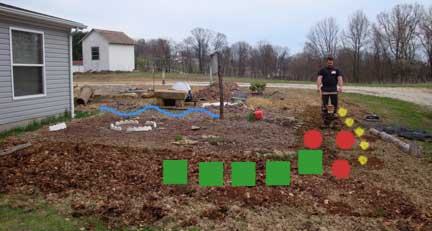
Currently there are two varieties of dwarf evergreens: Mugo Pine and Thuja Occidentalis 'Mr. Bowling Ball'. I kid you not! Well, to clarify, let me say that there exist many more than two varieties of dwarf evergreens, but I personally have purchased only the aforementioned two. The label—and who in their right mind would ever purchase a plant sans label?—states: "Mr. Bowling Ball Arborvitae, Dwarf shrub forming a perfect ball about 3' in diameter. Dense, evergreen foliage never needs pruning!" Okay, the label didn't include the exclamation mark, that was my addition, for truly it must have been an oversight on their part, don't you think? I mean, how fantastic is it that it grows in a perfectly spherical shape and never needs pruning?! How is that even possible? I am ready to be amazed.
An interesting offshoot of this foray into gardening is that label reading has become a passion of mine. I just love the formality of the Latin names, especially when followed with a common name as wonderful as 'Mr. Bowling Ball'. It gives rise to all manner of imaginings. For example, and I hope it doesn't surprise you too greatly to discover that I am not an expert in Latin, but doesn't Thuja occidentalis sound as if a Norwegian accidentally knocked out someone's teeth?
Actually, I think this moniker was the direct result of a national grade school contest to "Name the Shrubbery!" Once the judges read "Mr. Bowling Ball" how could they choose anything else? It was meant to be. Some fifth grader probably won a lifetime's supply of evergreens and two gallons of Miracle Gro, although I did not see a proud, smiling face anywhere on the label, so perhaps not. Anyway, I now present Pinus mugo 'Enci" Mugo Pine and Thuja occidentalis 'Mr. Bowling Ball' for your horticultural enjoyment. Ta-da!

(Mugo pine on the left, Mr. Bowling Ball on the right) If you're now thinking that there are only two shrubs in photo #2 and yet five green squares in photo #1, let me assure you that it was not an oversight or a misprint. I currently have four dwarf shrubs and plan to buy one more, probably a Dwarf Alberta Spruce. I'd give you the Latin name but since I haven't yet purchased one, I have no label, and somehow I don't think it's as intriguing as dear Mr. Bowling Ball.
I have read several books on gardening, including Month-to-Month Gardening in Ohio; Treasury of Gardening, and The Complete Garden Flower Book, and let me tell you, planning a garden requires knowledge, organization, creativity, and the strength to lug very heavy books from room to room. To be totally honest, I haven't read them straight through. I mean, would you read a chapter called "Getting Cozy with Woody Plants"? or "The Cultural Needs of Your Plants"? Next thing you know I'll be asking Sonny to hook up speakers so the plants can listen to classical music! That's just a step too far if you ask me. I'll just stick to the basics: "Preparing the Soil", "Quenching a Plant's Thirst", and decoding the "Zone Map: When's the Last Frost in Your Area".
Step One: Preparing the Soil. Without going into too much detail, suffice it to say that we don't have soil. We have clay and limestone substrate. What this means is that when it rains, all the water just sits there, creating soggy, heavy, mucky mud that clings to your boots, your tools, and your hands. One of the tests for determining the amount of clay in your soil is to squeeze a bit of soil in your hand and see if it falls apart or stays in a ball. Ours stays in a ball that eventually hardens into a marble that could roll clear across the deck. The substrate means we have no top soil, just loads of itty bitty rocks. Case in point: Sonny brought some pasture dirt mixed with aged cow manure and we tilled it into the "dirt" near the house. After only a few weeks, it looked as if we had purposely scattered rocks and pebbles around the entire flower bed before baking it into an impenetrable concrete slab. What this means is that before we can plant anything we have to dig a very big hole, add some peat moss, sand, dried leaves, real dirt, and mix it all up before finally settling a plant in the hole. A very thoughtful and generous friend has brought us two loads of dried leaves, with a bonus of manure! Then my trusty assistants amended the nasty clay. We're cooking now!
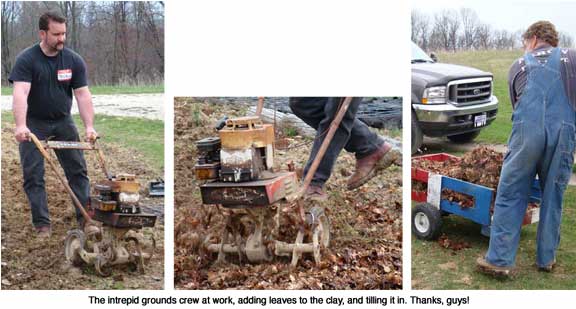
As hard as it is to believe, some plants have thrived here. Turns out we have fertile clay. Which means some extraordinarily unlucky people are cursed with unfertile clay! Perish the thought. Mom's hostas, which I'd transplanted from her previous back yard garden, have done so well in the front that they were twice as big as they'd ever grown before. Henceforth and forthwith, they had to be moved away from the house.
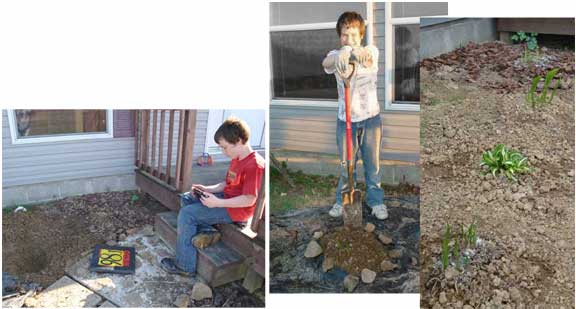
Enter my wonderful helper and grandson, who made it look sooo easy!
Step Two: Quenching a Plant's Thirst. For some unknown reason, our well pump isn't anywhere near the bottom of the well. This necessitates our being constantly aware of and conservative in our water use. If only the three of us are at home, no visitors, we can do one large and one extra small load of laundry, wash dishes using a minimum of wash and rinse water, and still take showers at the end of the day—during the winter. During gardening months, it means we can't water the plants around the house without seriously risking running the well dry, which in turn means no flushing, no drinking, no washing. This is to be avoided at all costs. Our goal then is not to thoroughly quench a plant's thirst, but merely to keep it from burning up, wilting, or becoming dust in the wind. Sorry, MJ. Your advice to "Water, water, water" doesn't wash.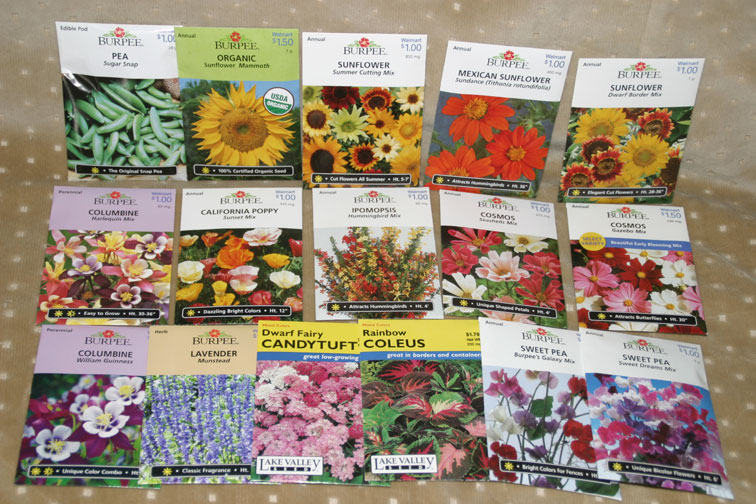
Step Three: Choosing Plants. I told my sister MJ (who has designed Mom's garden for the last two years), I told her quite firmly that we have to use more perennials, or annuals that re-seed, or things that spread by themselves, so there's not so much to do each year. IMHO, annuals should go in one or two small sections—they're so much more work to keep replanting and redesigning. So, with that in mind, and in an effort to keep costs down, I bought some seed packets to start inside.
Please note the two packages on the left, the ones with a light purple background. They're the perennials.
Step Four: Start seeds inside. The thinking here is that you'll know what's popping out of the ground, and you'll have plants that are hardy and ready to transplant outside "after all danger of frost is past." The first problem I see with this is that you can't "start" seeds until after they're available for purchasing in stores. The second problem is that if one reads the directions on the back of the packages (which, of course, I do, repeatedly), one can see that even buying them in early April (which I did) makes you already four to six weeks LATE in planting them! But since all this so-called timing hinges on an imaginary date that no one can safely or reliably predict, I figured what the heck, plant 'em anyway. Have you ever seen one of those so-called Zone Maps?
First of all, why do these people persist in using two barely different colors for things in close proximity? Couldn't Ohio, for example, be light yellow and light orange and some other state be dark yellow and dark orange? And, for something titled, in bold no less, "Zone Map: The Last Frost in Your Area" do you see a single date listed anywhere on the map or the legend? I see the average annual minimum temperatures. I see a list of temperatures and their corresponding zone numbers. But is there a date anywhere that tells me when the last frost is in my area? No! No, there is no date! Someone spent a lot of time drawing squiggly lines and tiny boxes and filling them in with indistinguishable colors and yet there is not one single date listed on the page. Not only that but in the text accompanying the chart, it has the nerve to state that "It is the most useful single guide for determining which plants are likely to survive in your garden and which ones are not." I can't let those silly things control my actions.
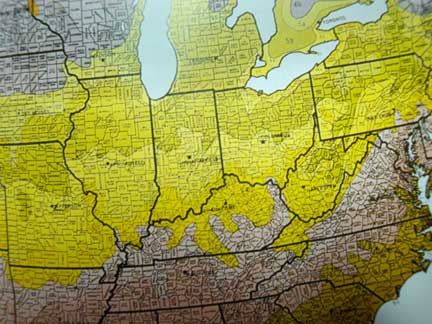
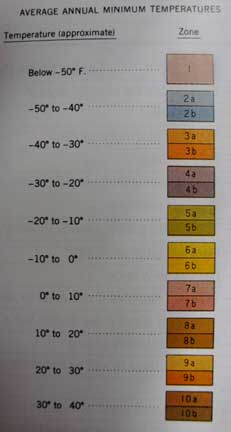
Therefore, in April, when I purchased the seeds, I planted some. Lo and behold, some came up. The seeds actually sprouted and grew! Go figure!!! Note the clever ID tags made by cutting yogurt containers and using an indelible marker to write, not only the name and variety, but also the number of days to germination, the number of pots for that particular flower, and the number of seeds started
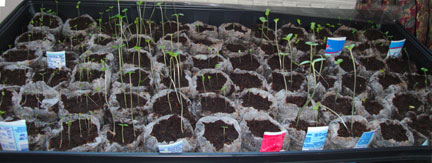 in each pot. Unfortunately, the picture was taken from the wrong side and all you can see are bits and pieces of the yogurt container itself, so you'll have to take my word for it—the plan was brilliantly conceived and executed.
in each pot. Unfortunately, the picture was taken from the wrong side and all you can see are bits and pieces of the yogurt container itself, so you'll have to take my word for it—the plan was brilliantly conceived and executed.
These are beefsteak tomatoes. Well, they're not actually tomatoes yet but they will be later, if I can protect them from the voracious and 
 disgusting tomato worms which wreaked havoc on last year's plants. Okay, they won't be the exact same worms as last year because I killed them all. Yes, sirree! If I were the type of person to notch her belt as a record of confirmed kills, I'd hardly have a belt left there'd be so many notches on it! Absolutely disgusting! Blech! Gross! But I digress...
disgusting tomato worms which wreaked havoc on last year's plants. Okay, they won't be the exact same worms as last year because I killed them all. Yes, sirree! If I were the type of person to notch her belt as a record of confirmed kills, I'd hardly have a belt left there'd be so many notches on it! Absolutely disgusting! Blech! Gross! But I digress...
Step Five: Keep costs down by using only the seedlings and seeds already purchased and planted.
This is me, carrying in a box full of plants. Grasses. Flowers. Pretty flowers. Cute flowers.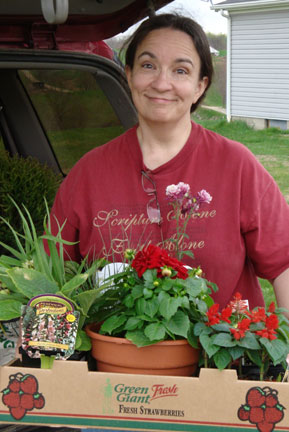 Flowers that look exactly like the seeds-growing-into-plants that I already have. Ray insisted that he be able to document the insanity. Hence the inane expression on my face. Well, that and the fact that I'M BUYING PLANTS AGAIN!!! Help me, please. Help me. It's insidious. At first it's all, "Isn't this pretty! Ooh, look at the pretty flowers! Ooh, won't that look wonderful next to the deck?" Later it's all, "Oh my gosh! Do those dumb things need watering again?!" and "But I just pulled all the weeds yesterday!" or "Why is that stupid thing all wilty and flopping over?!" You know it's true. It's always true.
Flowers that look exactly like the seeds-growing-into-plants that I already have. Ray insisted that he be able to document the insanity. Hence the inane expression on my face. Well, that and the fact that I'M BUYING PLANTS AGAIN!!! Help me, please. Help me. It's insidious. At first it's all, "Isn't this pretty! Ooh, look at the pretty flowers! Ooh, won't that look wonderful next to the deck?" Later it's all, "Oh my gosh! Do those dumb things need watering again?!" and "But I just pulled all the weeds yesterday!" or "Why is that stupid thing all wilty and flopping over?!" You know it's true. It's always true.
Step Six: Enjoy and appreciate the results even when you don't enjoy or understand the process.
I shall, indeed, continue to enjoy the beauty of the flowers already in bloom in the front garden: daffodils, tulips, crocuses, and these little beauties from who knows where. They don't look like anything I planted last year. Really! I checked the packages. Nothing. They don't have striped leaves like crocus, they're not shaped like anemone, they're definitely not tulips. I don't know what they are or where they came from. But they're pretty and I hope they come up again next year.
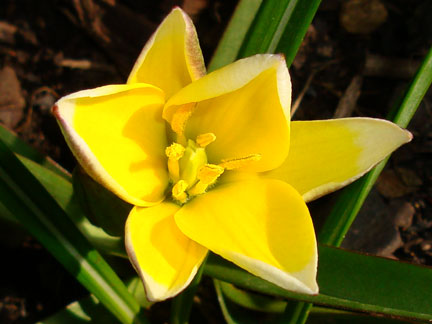
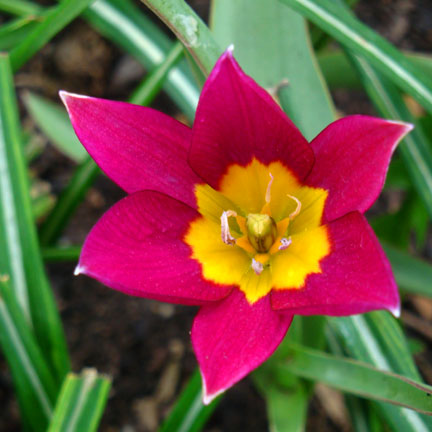
This one is an anemone. MJ warned me, and I quote, "Oh, Chris. Anemone will break your heart. They never grow or come back. They're pretty and full of promise but they'll break your heart." Hmm, on this one occasion, she appears to have been wrong for this is definitely anemone and it came back from last year. Sadly, she's also partly right. Very few of the bulbs in this area grew or bloomed, and absolutely none of the 40 (yes, 40!) that I planted near the arbor came up. But this is one that did. And I'm glad.
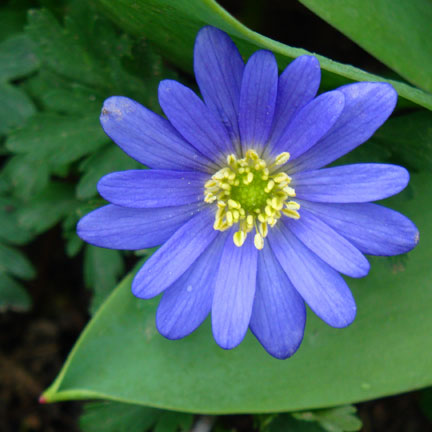
Thus ends, at least temporarily, another gardening lesson. I hope you can benefit from my learning and my losses.
Chris
Nada Farm Wife
Nada Gardener
 The Farm Wife, didn't expect most of this, and wondering how I got here?
The Farm Wife, didn't expect most of this, and wondering how I got here?
Keep coming back, page eight follows......soon.